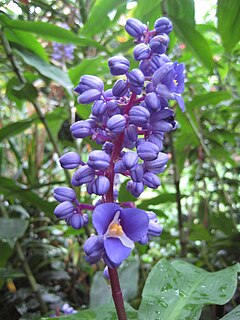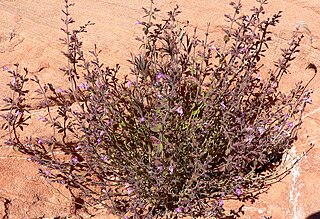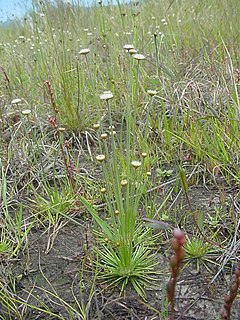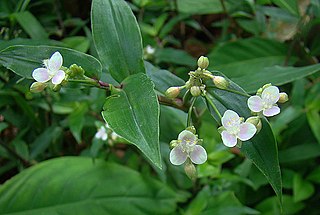
Manihot is a genus in the diverse milkspurge family, Euphorbiaceae. It was described as a genus in 1754.

Dichorisandra is a genus of perennial monocotyledonous flowering plants in the dayflower family (Commelinaceae). It is found in the neotropics. The genus is characterised by its slightly zygomorphic flowers with large anthers usually releasing pollen by means of pores at the apex, as well as by its seeds that are embedded in a red or sometimes white aril, and tubers that often form at the tips of the roots. Both morphology and an analysis of DNA sequences indicate it is very closely related to the genus Siderasis.

Billbergia is a genus of flowering plants in the family Bromeliaceae, subfamily Bromelioideae. The genus, named for the Swedish botanist, zoologist, and anatomist Gustaf Johan Billberg, is divided into two subgenera: Billbergia and Helicodea. They are native to forest and scrub, up to an altitude of 1,700 m (5,577 ft), in southern Mexico, the West Indies, Central America and South America, with many species endemic to Brazil.

Hedeoma is a genus of flowering plants in the mint family, Lamiaceae. It is native to North and South America. They are commonly known as false pennyroyals.

Lepechinia is a genus of plants in the mint family, Lamiaceae. It includes several species of plants known commonly as pitchersages. Plants of this genus can be found in Central and South America, Mexico, California, Hispaniola, and Hawaii, although the species in Hawaii is probably a human introduction. Many of them bear attractive pitcher-shaped flowers, often in shades of purple. The genus was named for the Russian botanist Ivan Ivanovich Lepechin. Recently, the two monotypic genera Chaunostoma and Neoeplingia were shown to be part of Lepechinia.
- Lepechinia anomalaEpling - southern Brazil
- Lepechinia bellaEpling - Bolivia
- Lepechinia betonicaefolia(Lam.) Epling - Colombia, Ecuador
- Lepechinia bullata (Kunth) Epling - Colombia, Ecuador, Venezuela
- Lepechinia calycina(Benth.) Epling ex Munz – pitcher sage, woodbalm - California
- Lepechinia cardiophyllaEpling – Santa Ana pitcher sage - southern California, Baja California
- Lepechinia caulescens(Ortega) Epling - Mexico, Guatemala
- Lepechinia chamaedryoides(Balb.) Epling - Chile
- Lepechinia cocuyensisJ.R.I.Wood - Colombia
- Lepechinia codonEpling - Peru
- Lepechinia conferta(Benth.) Epling - Colombia, Venezuela
- Lepechinia dioicaJ.A.Hart - Ecuador
- Lepechinia flammeaMart.Gord. & Lozada-Pérez - Guerrero
- Lepechinia floribunda(Benth.) Epling - Peru, Bolivia, Argentina
- Lepechinia fragrans(Greene) Epling – island pitcher sage, fragrant pitcher sage - southern California including offshore Channel Islands
- Lepechinia ganderiEpling – San Diego pitcher sage - southern California, Baja California
- Lepechinia glomerataEpling - Jalisco
- Lepechinia hastata(A.Gray) Epling – pakata - Baja California and Baja California Sur, including Revillagigedo Islands; naturalized in Hawaii
- Lepechinia heteromorpha (Briq.) Epling - Ecuador, Peru, Bolivia
- Lepechinia lamiifolia(Benth.) Epling - Ecuador, Peru
- Lepechinia lancifolia(Rusby) Epling - Bolivia
- Lepechinia leucophylloides(Ramamoorthy, Hiriart & Medrano) B.T.Drew, Cacho & Sytsma - Hidalgo
- Lepechinia maricaEpling & Mathias - Peru
- Lepechinia mecistandra(Donn.Sm.) H.K.Moon - Chiapas, Guatemala, El Salvador
- Lepechinia mexicana(S.Schauer) Epling - central + northeastern Mexico
- Lepechinia meyenii(Walp.) Epling - Peru, Bolivia, Argentina
- Lepechinia mollis(Epling) Epling - Peru
- Lepechinia mutica(Benth.) Epling - Ecuador
- Lepechinia nelsonii(Fernald) Epling - central + southern Mexico
- Lepechinia paniculata(Kunth) Epling - Ecuador
- Lepechinia radula (Benth.) Epling - Ecuador, Peru
- Lepechinia rossiiS.Boyd & Mistretta – Ross' pitcher sage - southern California
- Lepechinia rufocampiiEpling & Mathias - Ecuador
- Lepechinia salviae(Lindl.) Epling - Chile
- Lepechinia salviifolia(Kunth) Epling - Colombia, Venezuela
- Lepechinia schiedeana(Schltdl.) Vatke - Mexico, Guatemala, Costa Rica, Panama, Colombia, Venezuela
- Lepechinia scobinaEpling - Peru
- Lepechinia speciosa(A.St.-Hil. ex Benth.) Epling - southern Brazil
- Lepechinia tomentosa(Benth.) Epling - Peru
- Lepechinia urbani (Briq.) Epling - Hispaniola
- Lepechinia velutinaJ.R.I.Wood - Colombia
- Lepechinia vesiculosa(Benth.) Epling - Peru, Bolivia, Argentina
- Lepechinia vulcanicolaJ.R.I.Wood - Colombia
- Lepechinia yecoranaHenrickson, Fishbein & T.Van Devender - Sonora

Syngonanthus is a genus of plant in family Eriocaulaceae. It is native to tropical Africa and to Latin America.

Sarcoglottis is a genus of flowering plants from the orchid family, Orchidaceae. It is widespread across much of Latin America from Mexico to Argentina, with one species extending northward into Trinidad and the Windward Islands.

Herreria is a genus of flowering plants native to South America. In the APG III classification system, the genus is placed in the family Asparagaceae, subfamily Agavoideae.
- Herreria bonplandiiLecomte - Argentina, Paraguay, Uruguay
- Herreria cipoanaRavenna - Minas Gerais
- Herreria glazioviiLecomte - Bolivia, Brazil
- Herreria grandifloraGriseb. - Rio de Janeiro
- Herreria latifoliaWoodson - Minas Gerais, Bolivia
- Herreria montevidensisKlotzsch ex Griseb. in C.F.P.von Martius - Argentina, Paraguay, Uruguay, Bolivia
- Herreria salsaparilhaMart. - Brazil
- Herreria stellataRuiz & Pav. - Chile

Actinocephalus is a genus of plants in the Eriocaulaceae, first described in 2004. The entire genus is endemic to Brazil. It was formerly regarded as part of the related genus Paepalanthus, but recent studies have suggested that the two groups are better separated.

Cunila is a genus of plants in the Lamiaceae, first described in 1759. It is native to North and South America.
- Cunila angustifoliaBenth. - southern Brazil, Misiones Province of Argentina
- Cunila crenataGarcía-Peña & Tenorio - State of Durango in Mexico
- Cunila fasciculataBenth. - southern Brazil
- Cunila galioidesBenth. - Brazil
- Cunila incanaBenth. - southern Brazil, Argentina
- Cunila incisaBenth. - southern Brazil
- Cunila leucanthaKunth ex Schltdl. & Cham. - Mexico, Central America
- Cunila lythrifoliaBenth. - central + southern Mexico
- Cunila menthiformisEpling - southern Brazil
- Cunila menthoidesBenth. - Uruguay
- Cunila microcephalaBenth. - southern Brazil, Argentina, Uruguay
- Cunila origanoides(L.) Britton - central + eastern United States from Texas and Kansas east to New York and Georgia
- Cunila platyphyllaEpling - southern Brazil
- Cunila polyanthaBenth. - Mexico, Central America
- Cunila pycnanthaB.L.Rob. & Greenm. - Mexico
- Cunila ramamoorthianaM.R.Garcia-Pena - Mexico (Guerrero)
- Cunila spicataBenth. - southern Brazil, Argentina, Uruguay, Paraguay
- Cunila tenuifoliaEpling - southern Brazil

Eriope is a genus of plants in the family Lamiaceae, first described in 1833. It is native to South America, many of the species endemic to Brazil.
- Eriope alpestrisMart. ex Benth. - Minas Gerais
- Eriope anamariaeHarley - Bahia
- Eriope angustifoliaEpling - Minas Gerais
- Eriope arenariaHarley - Minas Gerais
- Eriope blanchetii(Benth.) Harley - northeastern Brazil
- Eriope complicataMart. ex Benth. - Brazil
- Eriope confusaHarley - Bahia
- Eriope crassifoliaMart. ex Benth. - Bahia
- Eriope crassipesBenth. - Brazil, Paraguay, Venezuela, French Guiana, Bolivia, Colombia
- Eriope exaltataHarley - Bahia
- Eriope filifoliaBenth. - Minas Gerais
- Eriope foetidaA.St.-Hil. ex Benth. - Brazil
- Eriope glandulosa(Harley) Harley - Bahia, Minas Gerais
- Eriope hypenioidesMart. ex Benth. - Bahia
- Eriope hypoleuca(Benth.) Harley - Bahia, Minas Gerais
- Eriope latifolia(Mart. ex Benth.) Harley - eastern Brazil
- Eriope luetzelburgiiHarley - Bahia
- Eriope machrisae(Epling) Harley - Goiás
- Eriope macrostachyaMart. ex Benth. - Brazil, Paraguay, Venezuela
- Eriope montanaHarley - Bahia
- Eriope monticolaMart. ex Benth. - Bahia
- Eriope obovataEpling - northeastern Brazil
- Eriope parvifoliaMart. ex Benth. - Brazil
- Eriope polyphyllaMart. ex Benth. - Bahia
- Eriope salviifolia(Pohl ex Benth.) Harley - Bahia, Minas Gerais
- Eriope sincoranaHarley - Bahia
- Eriope tumidicaulisHarley - Bahia
- Eriope velutinaEpling - Brazil
- Eriope xavantiumHarley - Mato Grosso
Glechon is a genus of flowering plants in the mint family, Lamiaceae, first described in 1827. It is native to South America.
- Glechon ciliataBenth. - southern Brazil, northern Argentina, Paraguay, Uruguay
- Glechon discolorEpling - southern Brazil
- Glechon ellipticaC.Pereira & Hatschbach - Paraná
- Glechon hoehneanaEpling - southern Brazil
- Glechon marifoliaBenth. - southern Brazil, Misiones Province of Argentina, Paraguay, Uruguay
- Glechon spathulataBenth. - southern Brazil, Misiones Province of Argentina
- Glechon thymoidesSpreng. - southern Brazil, Misiones Province of Argentina, Uruguay
Hoehnea is a genus of plants in the family Lamiaceae, first described with this name in 1939. It is native to South America, primarily southern Brazil.

Hypenia is a genus of flowering plants in the mint family, Lamiaceae, first described as a genus in 1988. It is native to South America and southern Mexico.
- Hypenia aristulata(Epling) Harley - Goiás
- Hypenia brachystachys(Pohl ex Benth.) Harley - southern Brazil
- Hypenia calycina(Pohl ex Benth.) Harley - Brazil
- Hypenia concinna(Benth.) Harley - Tocantins
- Hypenia crispata(Pohl ex Benth.) Harley - Goiás
- Hypenia densiflora(Pohl ex Benth.) Harley - Brazil
- Hypenia durifolia(Epling) Harley - Brazil
- Hypenia gardneriana(Benth.) Harley - Brazil
- Hypenia glauca(A.St.-Hil. ex Benth.) Harley - Brazil, Paraguay
- Hypenia inelegans(Epling) Harley - Brazil
- Hypenia irregularis(Benth.) Harley - Brazil
- Hypenia macrantha(A.St.-Hil. ex Benth.) Harley - Brazil
- Hypenia macrosiphon(Briq.) Harley - Brazil, Paraguay, Bolivia
- Hypenia marifolia(Benth.) Harley - Brazil
- Hypenia micrantha(Benth.) Harley - Mato Grosso
- Hypenia paniculata(Benth.) Harley - Brazil
- Hypenia paradisi(Harley) Harley - Goiás
- Hypenia pauliana(Epling) Harley - Brazil
- Hypenia perplexa(Epling) Harley - Brazil
- Hypenia pruinosa(Pohl ex Benth.) Harley - Brazil
- Hypenia reticulata(Mart. ex Benth.) Harley - eastern Brazil
- Hypenia salzmannii(Benth.) Harley - Brazil, Guyana, Venezuela
- Hypenia simplex(A.St.-Hil. ex Benth.) Harley & J.F.B.Pastore - Brazil
- Hypenia subrosea(Harley) Harley - Goiás
- Hypenia violaceaMart.Gord. & S.Valencia - Guerrero, Oaxaca
Rhabdocaulon is a genus of plants in the family Lamiaceae, first described as a genus in 1936. It is native to South America.
- Rhabdocaulon coccineum(Benth.) Epling - southern Brazil
- Rhabdocaulon denudatum(Benth.) Epling - Brazil
- Rhabdocaulon erythrostachysEpling - southern Brazil
- Rhabdocaulon gracile(Benth.) Epling - southern Brazil
- Rhabdocaulon lavanduloides (Benth.) Epling - southern Brazil
- Rhabdocaulon stenodontum(Briq.) Epling - southern Brazil, Paraguay, northeastern Argentina
- Rhabdocaulon strictum(Benth.) Epling - southern Brazil, Uruguay, northeastern Argentina

Tripogandra is a genus of flowering plants in the spiderwort family, Commelinaceae. It is native to the Western Hemisphere from central Mexico and the West Indies south to Argentina.

Ditassa is a genus of plant in the family Apocynaceae, first described as a genus in 1810. It is native to South America.
Cantinoa is a genus of plants with 27 species in the family Lamiaceae, first described in 2012. It is native primarily to New World, with some species introduced in the old world.
- Cantinoa althaifolia Harley & J.F.B.Pastore
- Cantinoa americana (Aubl.) Harley & J.F.B.Pastore
- Cantinoa carpinifolia (Benth.) Harley & J.F.B.Pastore
- Cantinoa colombiana (Epling) Harley & J.F.B.Pastore
- Cantinoa dubia Harley & J.F.B.Pastore
- Cantinoa duplicatodentata Harley & J.F.B.Pastore
- Cantinoa erythrostachys (Epling) Harley & J.F.B.Pastore
- Cantinoa heterodon (Epling) Harley & J.F.B.Pastore
- Cantinoa impar (Epling) Harley & J.F.B.Pastore
- Cantinoa indivisa (Pilg.) Harley & J.F.B.Pastore
- Cantinoa macroptera (Briq.) Harley & J.F.B.Pastore
- Cantinoa multiseta (Benth.) Harley & J.F.B.Pastore
- Cantinoa muricata Harley & J.F.B.Pastore
- Cantinoa mutabilis (Rich.) Harley & J.F.B.Pastore
- Cantinoa nanuzae Harley
- Cantinoa x obvallata (Benth.) Harley & J.F.B.Pastore
- Cantinoa pinetorum (Epling) Harley & J.F.B.Pastore
- Cantinoa plectranthoides (Benth.) Harley & J.F.B.Pastore
- Cantinoa propinqua (Epling) Harley & J.F.B.Pastore
- Cantinoa racemulosa Harley & J.F.B.Pastore
- Cantinoa rubicunda Harley & J.F.B.Pastore
- Cantinoa similis (Epling) Harley & J.F.B.Pastore
- Cantinoa stricta (Benth.) Harley & J.F.B.Pastore
- Cantinoa subrotunda Harley & J.F.B.Pastore
- Cantinoa x sylvularum Harley & J.F.B.Pastore
- Cantinoa villicaulis (Epling) Harley & J.F.B.Pastore
- Cantinoa violacea Harley & J.F.B.Pastore
Cyanocephalus is a genus of flowering plants belonging to the family Lamiaceae.













